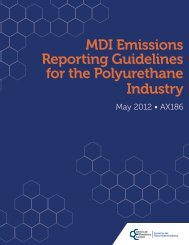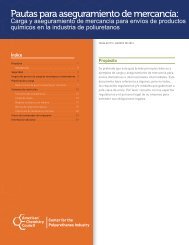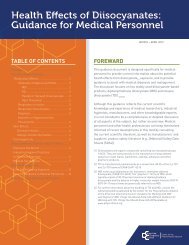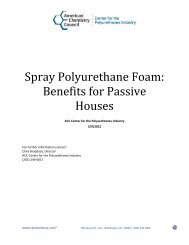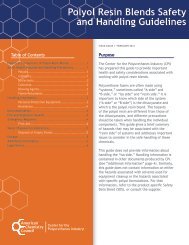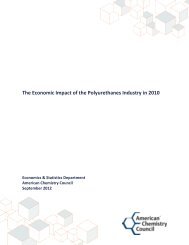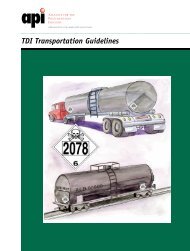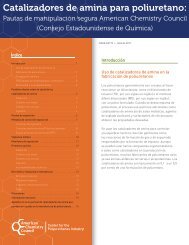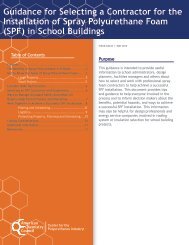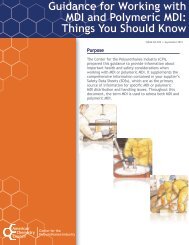Polyurethane Amine Catalysts - Polyurethanes - American ...
Polyurethane Amine Catalysts - Polyurethanes - American ...
Polyurethane Amine Catalysts - Polyurethanes - American ...
Create successful ePaper yourself
Turn your PDF publications into a flip-book with our unique Google optimized e-Paper software.
<strong>Polyurethane</strong> Polyuret ne <strong>Amine</strong> <strong>Catalysts</strong>: C<br />
Safe afe Handling Guidelines<br />
Table e of Contents<br />
Introduction ....................................... 1<br />
Use of <strong>Amine</strong> <strong>Catalysts</strong> in <strong>Polyurethane</strong>s Manufacture . 1<br />
Chemical Composition ........................... 1<br />
Flammability and Combustive Properties ............ 2<br />
Reactivity and Incompatibilities .................... 2<br />
Potential Health Effects of <strong>Amine</strong> <strong>Catalysts</strong> ............ 2<br />
Inhalation . ..................................... 3<br />
Skin Contact . .................................. 3<br />
Eye Contact . ................................... 4<br />
Ingestion . ..................................... 4<br />
Exposure Guidelines ................................ 6<br />
Methods for Exposure Control ........................ 7<br />
Engineering Controls . ........................... 7<br />
Administrative Controls/Work Practices . ............ 8<br />
Personal Protective Equipment (PPE) . .............. 8<br />
Medical Surveillance ............................... 10<br />
Exposure Monitoring ................................ 11<br />
First Aid .......................................... 12<br />
Inhalation . ..................................... 12<br />
Skin Contact . .................................. 12<br />
Eye Contact . ................................... 12<br />
Ingestion . ..................................... 12<br />
Chemical Incompatibilities . ...................... 13<br />
Spills and Emergency Response ..................... 13<br />
Minor Spills . ................................... 13<br />
Major Spills . ................................... 13<br />
Clean-up and Decontamination . ................... 13<br />
Fire ........................................... 14<br />
Disposal .......................................... 14<br />
Additional Information ............................. 15<br />
<br />
That May Be Used In <strong>Polyurethane</strong>s Manufacture ........ 16<br />
<br />
Introduction<br />
Use of <strong>Amine</strong> <strong>Catalysts</strong> in<br />
<strong>Polyurethane</strong>s Manufacture<br />
<strong>Polyurethane</strong>s are generally made by reacting a<br />
diisocyanate, such as toluene diisocyanate (TDI) or<br />
methylene diphenyl diisocyanate (MDI), and a blended<br />
polyol. When a polyurethane foam is desired, the<br />
process uses additional chemicals, such as amine and/<br />
or metallic salt catalysts, auxiliary blowing agents, and<br />
silicone surfactants, to achieve the desired properties.<br />
<strong>Amine</strong> catalysts are used to control and/or balance both<br />
the gelling reaction and the gas-forming or foaming<br />
reaction responsible for foam formation. Although<br />
several organometallic compounds or salts may be<br />
used as catalysts in the production of polyurethanes,<br />
many polyurethane manufacturers use either tertiary<br />
aliphatic amines or alkanolamines. <strong>Amine</strong> catalysts are<br />
typically 0.1 to 5.0 percent of a polyurethane formulation.
There are four potential<br />
routes of exposure to amine<br />
catalysts: INHALATION,<br />
SKIN CONTACT, EYE<br />
CONTACT, AND INGESTION<br />
Center for the<br />
<strong>Polyurethane</strong>s Industry<br />
Chemical Composition<br />
<strong>Amine</strong> catalysts are a class of organic compounds derived from ammonia (NH3)<br />
by substituting one or more of the hydrogen atoms with alkyl groups (carbon<br />
and hydrogen containing molecular chains)—e.g., dimethylcyclohexylamine<br />
[(CH3)2NC6H11]. An amine is primary, secondary, or tertiary depending on whether<br />
one, two, or three of the hydrogen atoms of ammonia are replaced. Most amines are<br />
basic and can combine readily with acids to form salts, some of which are useful<br />
as delayed-action catalysts. Catalytic activity of tertiary amines depends on<br />
their structure and basicity. All tertiary amines have a very distinct and strong<br />
ammonia-like odor.<br />
Because there are different types of amine catalysts, a detailed description of<br />
the physical and chemical properties of amine catalysts is beyond the scope of<br />
this document. Consult the manufacturer’s Material Safety Data Sheet (MSDS) for<br />
specific information.<br />
Flammability and Combustive Properties<br />
Like many organic materials, amine-containing compounds will burn when exposed<br />
to sufficient heat, a source of ignition, and oxygen. This is especially true of vapors<br />
and mists, which are susceptible to sudden spontaneous combustion when mixed<br />
with air. Generally, liquid amine catalysts exhibit flash points in the range of 20°F to<br />
115°F (-7°C to 46°C). The flash points of mixtures or blended components may be<br />
altered in the presence of water or other components.<br />
The combustion of tertiary amine catalysts may yield a variety of toxic gases,<br />
including carbon monoxide, carbon dioxide, ammonia and nitrogen oxides.<br />
Reactivity and Incompatibilities<br />
Generally, liquid amine catalysts are corrosive and alkaline. Avoid using copper and<br />
copper copper containing alloys such as brass or bronze with anime catalysts.
Potential Health Effects of <strong>Amine</strong> <strong>Catalysts</strong><br />
This section provides a brief overview of information pertaining to potential health hazards associated with<br />
amine catalysts. This information is necessarily general in nature, since there are many amine catalysts used in<br />
polyurethane manufacture. A comprehensive discussion of health information pertaining to amine catalysts is<br />
beyond the scope of these Guidelines. For more information, you may want to contact your supplier, or consult the<br />
Material Safety Data Sheet (MSDS) specific to the amine catalyst of interest.<br />
Typically, there are four potential routes of exposure to amine catalysts: inhalation, skin contact, eye contact, and<br />
ingestion, though ingestion is unlikely in the workplace. Consult the appropriate MSDS for specific details about<br />
potential acute and chronic effects of the particular amine catalyst used.<br />
The adverse health effects listed below are applicable to aliphatic amines as a group and not necessarily to each<br />
specific catalyst. For more information, refer to the MSDS or contact your amine catalyst supplier and/or an<br />
experienced occupational physician.<br />
Inhalation<br />
Inhalation may result in moderate to severe irritation of nose, throat and lungs, manifesting as nasal discharge,<br />
difficulty breathing, and cough. Certain irritating amines can cause severe respiratory track injury in the airways<br />
such as laryngeal edema with bronchospasm, or severe bronchitis. Damage to the lung tissue may result in<br />
chemical pneumonitis and pulmonary edema, causing severe respiratory distress and delayed scarring of the<br />
lungs. Chronic exposure to short chain amines (
4<br />
Center for the<br />
<strong>Polyurethane</strong>s Industry<br />
Table 1 - Acute Oral and Dermal Toxicity Classification*<br />
Classification Acute Oral LD50 Acute Dermal LD50<br />
Skin Contact<br />
Skin contact with amine catalysts can cause moderate to severe irritation and burns,<br />
from redness and swelling to painful blistering, ulceration, and chemical burns.<br />
Repeated or prolonged exposure may also result in severe contact dermatitis. In most<br />
instances, it will be irritant contact dermatitis, but dermal sensitization leading to<br />
allergic contact dermatitis has been associated with one amine catalyst (see Table 1)<br />
(Foti,2003, Hervella, 2006).<br />
Systemic effects resulting from the absorption of selected amines through the skin<br />
may include headaches, nausea, faintness, anxiety, decrease in blood pressure,<br />
reddening of the skin, hives, and facial swelling. These symptoms are related to<br />
histamine release and they are generally transient in nature.<br />
Eye Contact<br />
(rat mg/kg) (rabbit, mg/kg)<br />
Practically Nontoxic >5000 >5000<br />
Slightly Toxic 2000-5000 2000-5000<br />
Moderately Toxic 300-2000 1000-2000<br />
Toxic 50-300 200-1000<br />
Highly Toxic
Table 2 - Summary of Acute Toxicity Studies of <strong>Amine</strong>s Commonly Used in <strong>Polyurethane</strong>s<br />
Chemical Name<br />
Alkyl <strong>Amine</strong>s<br />
bis(2-Dimethylamino-<br />
ethyl)ether<br />
N,N-DimethylaminopropylamineN,N-Dimethylcyclohexylamine<br />
N,N,N’,N’,N”-Pentamethyldiethylenetriamine<br />
Trade Names,<br />
Common Names<br />
NIAX A-99;<br />
DABCO BL-19;<br />
TOYOCAT- ETS;<br />
JEFFCAT ZF-20<br />
Skin<br />
Effects a Eye Effects SkinSens c<br />
corrosive corrosive<br />
halovision b<br />
DMAPA corrosive corrosive<br />
halovision b<br />
POLYCAT 8;<br />
JEFFCAT DMCHA<br />
DESMORAPID-PV;<br />
POLYCAT 5;<br />
TO-YOCAT -DT;<br />
JEF-FCAT PMDETA<br />
Triethylenediamine TEDA;<br />
DABCO Crystal;<br />
RC Catalyst 105;<br />
JEFFCAT TD-100<br />
Ethanol <strong>Amine</strong>s<br />
Diethanolamine DABCO DEOA-LF;<br />
DEOA LFG;<br />
DEA<br />
2(2-Dimethylamino-<br />
ethoxy)ethanol<br />
N-[2-(dimethylamino)<br />
ethyl]-Nmethylethanolamine<br />
Dimethylethanolamine<br />
Other<br />
3-Dimethylamino-<br />
N,N-Dimethylpropionamide<br />
PAK-LOC V;<br />
JEFFCAT ZR-70;<br />
TOYOCAT –RX3<br />
DABCO T; TOYOCAT-<br />
RX5<br />
DABCO DMEA;<br />
JEFFCAT DMEA<br />
DDPA;<br />
NIAX A4;<br />
NIAX C-191<br />
N-Ethylmorpholine DABCO NEM;<br />
JEFFCAT NEM<br />
Inhalation<br />
LC50(rat)<br />
ppm<br />
No 117 ppm (6<br />
hr)<br />
Yes >1031 ppm<br />
(4 hr)<br />
corrosive corrosive No 476 ppm<br />
(females);<br />
375ppm<br />
(males) (6 hr)<br />
corrosive corrosive No 290 ppm (6<br />
hr) male &<br />
female rats<br />
mild/<br />
moderate<br />
irritant<br />
moderate/<br />
severe<br />
irritant<br />
severe<br />
irritant/<br />
corrosive<br />
severe<br />
irritant<br />
moderate<br />
to severe<br />
irritant<br />
halovision b<br />
severe<br />
irritant<br />
halovision b<br />
severe<br />
irritant<br />
halovision b<br />
severe<br />
irritant<br />
No >4402 ppm<br />
(1hr)<br />
Oral<br />
LD50<br />
(rat)<br />
mg/kg<br />
571-<br />
1236<br />
500-<br />
1870<br />
Dermal LD50<br />
(rabbit) mg/kg<br />
LD50(rabbit) mg/<br />
kg LD50(rabbit)<br />
mg/kg<br />
LD50(rabbit) mg/k<br />
122-750<br />
490<br />
272-650 210-543<br />
1330-<br />
1630<br />
700-<br />
3300<br />
No NA d 680-<br />
3460<br />
232-280<br />
>2000<br />
1220-13000<br />
No NA d 2337 1340<br />
No 1670 ppm<br />
(1hr)<br />
corrosive corrosive No 1461-1641<br />
(4 hr)<br />
1580-<br />
2520<br />
1420-<br />
2340<br />
corrosive corrosive No >41.7 ppm 1474-<br />
2400<br />
corrosive corrosive<br />
halovision b<br />
No >2000 ppm<br />
(4hr)<br />
1640-<br />
1780<br />
>1800<br />
1215<br />
1162-1767<br />
a Corrosivity information based on U.S. DOT corrosivity testing per 49 CFR Ch. I 173.137.<br />
b Halovision is a phenomenon associated with many amines (See “Eye Contact,” p. 7). The compounds listed as causing halovision are ones for which<br />
the effect has been documented.<br />
c Skin sensitization studies are typically conducted at minimally irritating concentrations.<br />
d NA= Not Available<br />
900-1980<br />
Center for the<br />
<strong>Polyurethane</strong>s Industry<br />
5
6<br />
Center for the<br />
<strong>Polyurethane</strong>s Industry<br />
Ingestion<br />
The oral toxicity of amine catalysts varies from slightly toxic to toxic based on animal<br />
studies (see Table 2). Ingestion of amines can cause severe irritation, ulceration, or<br />
burns of the mouth, throat, esophagus, and gastrointestinal tract. Material aspirated<br />
(due to vomiting) can damage the bronchial tubes and the lungs. Affected persons<br />
also may experience pain in the chest or abdomen, nausea, bleeding of the throat and<br />
the gastrointestinal tract, diarrhea, dizziness, drowsiness, thirst, circulatory collapse,<br />
coma, and even death.<br />
Exposure Guidelines<br />
A number of organizations and entities establish limits for airborne contaminants<br />
in the workplace. Generally called Occupational Exposure Limits (OELs), some are<br />
enforceable regulatory limits and others are guidance. OELs are typically established<br />
for a specific chemical or family of chemicals, and are directed to the specific hazards<br />
presented. The U.S. Occupational Safety and Health Administration (OSHA) sets<br />
enforceable permissible exposure limits (PELs) to protect workers against the health<br />
effects of exposure to hazardous substances. PELs are regulatory limits on the<br />
amount or concentration of a substance in the air, and they are legally enforceable.<br />
In Canada, the Ontario Ministry of Labour also sets OELs, and these have the force of<br />
law.<br />
Other OELs can be established by authoritative organizations such as the <strong>American</strong><br />
Conference of Governmental Industrial Hygienists (ACGIH). ACGIH develops and<br />
publishes Threshold Limit Values (TLVs) as guidelines, which are not considered<br />
legal requirements (unless they have been adopted<br />
as regulatory standards by national, state, or local<br />
governments). OELs are reviewed periodically by<br />
occupational health professionals and updated as<br />
new information becomes available.<br />
A number of<br />
organizations and<br />
entities establish<br />
limits for airborne<br />
contaminants in the<br />
workplace.
Table 3 - Permissible Exposure Levels and Threshold Limit Values of Some<br />
<strong>Polyurethane</strong> <strong>Amine</strong> <strong>Catalysts</strong><br />
<strong>Amine</strong> Catalyst CAS # Exposure Limit (Source)<br />
Dimethylcyclohexylamine, N,N- 98-94-2 STEL: 5 PPM (Ontario, Canada)<br />
N-ethylmorpholine 100-74-3 TWA: 5 ppm Skin1 (ACGIH)<br />
PEL: 20 ppm Skin2 (OSHA)<br />
Triethanolamine 102-71-6 TWA: 5 mg/m3 (ACGIH)<br />
Dimethylamino ethanol, 2- 108-01-0 TWA: 3 ppm (Ontario, Canada)<br />
STEL: 6 ppm (Ontario, Canada)<br />
N,N-Dimethylaminopropylamine 109-55-7 TWA: 0.5 ppm (ACGIH)<br />
Diethanolamine 111-42-2 TWA: 3 ppm (ACGIH)<br />
TLV: 1 mg/m3 (ACGIH)<br />
Triethylamine 121-44-8 PEL: 25 ppm (OSHA)<br />
STEL: 3 ppm (ACGIH)<br />
Triethylenediamine 280-57-9 TWA: 1 ppm Skin1 (Ontario, Canada)<br />
Bis (2-Dimethylaminoethyl) ether 3033-62-3 TWA: 0.05 ppm Skin1 (ACGIH)<br />
STEL: 0.15 ppm Skin1 (ACGIH)<br />
1 Potential for significant contribution to overall exposure by skin.<br />
2 Substance which may be absorbed through the skin.<br />
Most exposure criteria, such as Ontario’s OELs, OSHA PELs, and ACGIH TLVs, represent time-weighted average<br />
(TWA) concentrations where most members of a healthy, working population may be exposed repeatedly without<br />
adverse effects (8-hour day, 40-hour week). Furthermore, short-term exposures to elevated concentrations may<br />
be acceptable for many materials as long as the 8-hour TWA exposure is not exceeded. Short-term exposure<br />
limits (STELs) have been established for many materials which have an OEL, PEL or TLV. These STELs are 15<br />
minute TWAs that should not be exceeded during a workday even if the 8-hour TWA is within the criteria. Some<br />
amine catalysts also have ceiling exposure limits which indicate concentrations that should not be exceeded<br />
during exposure.<br />
Only a few of the polyurethane amine catalysts have been assigned OELs<br />
(see Table 3 for examples). Individuals who work with amine catalysts should stay informed of the most current<br />
standards governing exposure, understand the hazards associated with their use, and take precautions to avoid<br />
excessive exposure.<br />
Center for the<br />
<strong>Polyurethane</strong>s Industry<br />
7
8<br />
Center for the<br />
<strong>Polyurethane</strong>s Industry<br />
Methods for Exposure Control<br />
Exposure to amine catalyst vapor or aerosols may present potential health risks. In<br />
those instances where the results of an industrial hygiene evaluation indicate the<br />
potential for amine catalyst exposure outside the applicable OEL, measures can be<br />
taken to protect workers from exposure. The National Institute for Occupational<br />
Safety and Health (NIOSH) suggests that the use of engineering controls be<br />
considered first, followed by administrative controls and then personal protective<br />
equipment.<br />
Engineering Controls<br />
Engineering controls are used to remove a hazard or place a barrier between the<br />
worker and the hazard. Consider the use of local exhaust ventilation, where feasible,<br />
to reduce airborne vapors. Local exhaust ventilation should be designed to draw<br />
vapors and/or aerosols away from the operator’s breathing zone and designed<br />
to reduce airborne amine catalyst levels to acceptable concentrations at all work<br />
stations, including processing, fabricating, pouring, frothing, and spraying operations.<br />
Administrative Controls/Work Practices<br />
Administrative controls are generally described as written procedures and policies<br />
that help minimize the potential for exposures. For example, workers using any<br />
chemical, as well as amine catalysts, should follow proper handling procedures<br />
and utilize good work practices. Since it is important to avoid inadvertent contact<br />
with amine catalysts, including the possibility of ingestion, a good work practice is<br />
to prohibit consumption of food or beverages, use of tobacco or chewing gum, and<br />
application of cosmetics or other personal care products in the work area.<br />
Personal Protective Equipment (PPE)<br />
Personal protective equipment (PPE) is often used after appropriate and feasible<br />
engineering and administrative controls have been implemented. Selection of<br />
PPE begins with a review of statutory and regulatory requirements, such as those<br />
outlined by OSHA. It also takes into consideration applicable standards, such<br />
as ANSI standards, other relevant requirements and guidance, and site-specific<br />
circumstances. This discussion is necessarily general in nature; the manufacturer’s<br />
MSDS should be consulted for specific PPE recommendations for the amine catalyst<br />
of interest.
Chemical Protective Clothing<br />
The purpose of chemical protective clothing (CPC) is to prevent contact with materials that can injure or be absorbed<br />
through the skin or eyes. Compatability of the chemical with the CPC material is a critical criterion in the selection<br />
process. Where there is a possibility of direct contact with liquid amines, skin and eye protection may include, but is<br />
not limited to:<br />
Chemical goggles and face shield<br />
Neoprene, nitrile, or butyl rubber gloves (DO NOT USE latex; latex is chemically incompatible with amines)<br />
Rubber apron<br />
Long-sleeve coveralls<br />
Rubber-soled safety shoes or rubber boots<br />
Respiratory Protection<br />
For routine manufacturing operations, air-purifying respirators equipped with cartridges designed to protect<br />
against organic vapors or amines may be recommended by the manufacturer. Consult the manufacturer’s MSDS<br />
for specific information regarding respirator use and selection.<br />
For firefighting, cleaning up large spills, and other emergency operations, wear a self-contained breathing<br />
apparatus with full face-piece, operated in a pressure-demand mode. OSHA requires that these self-contained<br />
respirators be used in conjunction with a site-specific, written respiratory protection program, which would<br />
include training, suitable fit testing, and medical evaluation of the user. Air purifying respirators are not<br />
appropriate for use during firefighting or other emergency or upset conditions.<br />
PPE in Emergency Incidents<br />
Protective equipment should be used during emergency situations whenever there is a likelihood of exposure<br />
to liquid amines or to excessive concentrations of amine vapor. Examples of “emergency situations” include<br />
equipment failure, rupture of containers, or failure of control equipment that results in an uncontrolled release of<br />
amine liquid or vapor.<br />
Emergency protective equipment may consist of:<br />
Self-contained breathing apparatus, with full facepiece, operated in positive pressure or pressure-demand<br />
mode<br />
Neoprene, nitrile, or butyl rubber gloves (DO NOT USE latex; latex is chemically incompatible with amines)<br />
Long-sleeve coveralls or impervious full body suit<br />
Rubber apron<br />
Rubber-soled safety shoes or rubber boots<br />
Center for the<br />
<strong>Polyurethane</strong>s Industry<br />
9
Center for the<br />
<strong>Polyurethane</strong>s Industry<br />
Medical Surveillance<br />
Based on the risk assessments of potential exposure to amines, employers may<br />
require pre-placement and periodic medical examinations of their employees. These<br />
examinations can establish whether individuals may perform their duties without<br />
compromising their health. In addition, periodic medical evaluations can have<br />
significant value in the early detection of disease and in providing an opportunity for<br />
health counseling.<br />
The following medical surveillance guidance focuses on respiratory and skin effects<br />
that might be amine-related. These screens do not establish a definitive diagnosis.<br />
Follow-up by a physician experienced in occupational respiratory disease is advisable<br />
in order to properly establish a diagnosis.<br />
If you have any questions or would like further guidance in establishing medical<br />
surveillance in your workplace, contact your employer or amine catalyst supplier.<br />
Medical Surveillance Components and Frequency Pre-Placement and Baseline<br />
Testing<br />
History – with special emphasis on skin and respiratory tract<br />
Spirometry (Pulmonary Function Studies)<br />
Physical examination depending on the presence of other health risks<br />
Respirator medical evaluation per 29 CFR 1910.134 (when respirator use is<br />
required)<br />
Periodic Surveillance<br />
Medical History – with special emphasis on skin and respiratory tract<br />
Spirometry (Pulmonary Function Studies)<br />
Physical examination – by physician if there are positive findings in the Medical<br />
History or Spirometry<br />
Medical surveillance frequency to be determined by whether there are<br />
concurrent exposures to diisocyanates and use of respirators<br />
In addition, employers may want to offer exams in the following instances:<br />
Following an emergency situation involving amines<br />
If an employee complains of amine-associated signs or symptoms<br />
The components for these examinations will be determined by the health care<br />
professional, who should have been supplied with information about the health<br />
effects of the amine catalysts.
Exposure Monitoring<br />
Table 4 below illustrates physical properties and industrial hygiene sampling/analytical procedures for common<br />
polyurethane and polyisocyanurate amine catalysts.<br />
Table 4 - Physical Properties and Industrial Hygiene Sampling/Analytical Procedures<br />
for Common <strong>Polyurethane</strong> and Polyisocyanurate <strong>Amine</strong> <strong>Catalysts</strong><br />
Chemical Name<br />
Trade Names,<br />
Common Names<br />
bis(2-Dimethyamino-ethyl)ether POLYCAT 8<br />
NIAX A-99;<br />
DABCO BL-19;<br />
TOYOCAT ETS;<br />
JEFFCAT ZF-20;<br />
N,N-Dimethylcyclohexylamine POLYCAT 5;<br />
JEFFCAT DMCHA<br />
N,N,N’,N’,N”-<br />
Pentamethyldiethylenetriamine<br />
TOYOCAT – DT;<br />
JEFFCAT PMDETA<br />
Triethylenediamine TEDA;<br />
DABCO Crystal;<br />
RC Catalyst 105;<br />
JEFFCAT TD-100<br />
Diethanolamine DABCO DEOA-LF;<br />
DEOA LFG<br />
2(2-Dimethylaminoethoxy)ethanol PAK-LOC V;<br />
JEFFCAT ZR-70;<br />
TOYOCAT-RX5<br />
Dimethylethanolamine DABCO DMEA;<br />
JEFFCAT DMEA<br />
Vapor<br />
Pressure,*<br />
mm Hg @20ºC<br />
Industrial Hygiene Sampling/<br />
Analytical Procedures<br />
0.28 Crompton MethodXAD-2 Resin (100 mg/50<br />
mg)<br />
Bayer Method 2.10.3 XAD-2Resin (400<br />
mg/200 mg)<br />
2.2 Huntsman Method – Chromosorb-102 Resin<br />
Air Products Method - XAD-2 Resin<br />
BTR Method – Porasil B Resin +5%<br />
KOHNIOSH XAD-2 Resin<br />
0.42 Bayer Method 2.10.3 XAD-2 Resin (400<br />
mg/200 mg)<br />
Air Products Method - XAD-2 Resin<br />
0.45 Bayer Method 2.10.3 XAD-2 Resin (400<br />
mg/200 mg)<br />
Huntsman Method – Chromosorb-102 Resin<br />
Center for the<br />
<strong>Polyurethane</strong>s Industry<br />
First Aid<br />
Employee training can enhance the administration of appropriate first aid procedures<br />
after an exposure to an amine catalyst. Suitable emergency personnel may also<br />
need to be called depending on the severity of the accident. This guidance is general<br />
in nature; for specific first aid information, consult the MSDS for the specific amine<br />
being used. Always follow the first aid instructions in the MSDS.<br />
Inhalation<br />
Promptly move the affected person away from the contaminated area to an area<br />
of fresh air. Keep the affected person calm and warm, but not hot. If breathing<br />
is difficult, oxygen may be administered by a qualified person. If breathing stops,<br />
qualified persons should give artificial respiration. Call a physician at once.<br />
Skin Contact<br />
In the event of an amine catalyst spill or splash that results in skin exposure,<br />
promptly remove any contaminated clothing including rings, watches, and<br />
shoes, preferably under a safety shower. Wash skin for 15 to 30 minutes with<br />
plenty of flowing water. Call a physician immediately. Remove and dry-clean or<br />
launder clothing soaked or soiled with this material before reuse. Dry cleaning<br />
of contaminated clothing may be more effective than normal laundering. Inform<br />
individuals responsible for cleaning to avoid direct skin contact with those areas of<br />
clothing contaminated. Discard contaminated leather articles such as shoes, belts,<br />
and watchbands. Skin burns can be treated as thermal burns. The onset of dermal<br />
symptoms may be delayed, depending on the amine product. After decontamination,<br />
consider the use of cold packs and topical antibiotics.<br />
Eye Contact<br />
If liquid amines come in contact with the eyes, irrigate immediately and continuously<br />
with low pressure flowing water, preferably from an eye wash fountain, for 15 to 30<br />
minutes. For more effective flushing of the eyes, use the fingers to spread apart and<br />
hold open the eyelids. The eyes should then be “rolled” or moved in all directions.<br />
Seek immediate medical attention, preferably from an ophthalmologist. In the event<br />
of vapor contact leading to irritation, consider irrigation with low pressure flowing<br />
water, preferably from an eye wash fountain, for 15 minutes.
Ingestion<br />
If amine catalysts are ingested, consult the MSDS for specific first aid advice. It may be helpful to have the<br />
affected person drink several glasses of water or milk. Do not induce vomiting. Immediately transport to<br />
a medical facility and inform medical personnel about the nature of the exposure. If lavage is performed,<br />
endotracheal and/or esophagoscopic control is suggested. If the patient has ingested other chemicals, physicians<br />
should review the appropriate MSDSs to ensure treatments do not conflict.<br />
Chemical Incompatibilities<br />
Violent reaction and fire can result when amine catalysts are exposed to, or mixed with, oxidizing agents such as<br />
perchlorates, nitrates, permanganates, chromates, nitric and other strong acids, halogens, and some cleaning<br />
solutions containing acids. The large amount of heat generated by the reaction of the catalyst with the oxidizing<br />
agent may be sufficient to cause vigorous boiling, which can cause the hot material to splash or splatter. Latex<br />
(e.g., gloves) is not compatible with amine catalysts and should not be used in PPE.<br />
Spills and Emergency Response<br />
Minor Spills<br />
Small spills can be contained by diking. The amine catalyst may then be neutralized as recommended in<br />
the manufacturer’s MSDS. Absorb the neutralized product with an inert absorbant such as clay, sawdust, or<br />
vermiculite, and shovel into containers. Store the containers appropriately outdoors. Dispose of the material<br />
according to all federal, state, and local laws and regulations governing the disposal of chemical wastes. It is the<br />
user’s responsibility to properly characterize the waste materials and dispose of them in accordance with legal<br />
requirements. Waste materials from an amine catalyst spill may be characterized as hazardous wastes that are<br />
subject to special requirements under the federal Resource Conservation and Recovery Act (RCRA).<br />
Major Spills<br />
Consider diking the spill for spill containment, with consideration to entryways into municipal water systems,<br />
waterways, or other sensitive points. Contact the supplier’s emergency response center for advice and/or<br />
assistance. If the spill involves a tank car or tank truck, call CHEMTREC® (1-800-424-9300). A useful technique<br />
for addressing larger spills is to pump spilled material into drums during the response.<br />
Center for the<br />
<strong>Polyurethane</strong>s Industry<br />
13
14<br />
Center for the<br />
<strong>Polyurethane</strong>s Industry<br />
Clean-up and Decontamination<br />
Brooms and mops, along with any remaining absorbent, should be disposed of in<br />
accordance with all applicable federal, state, and local regulations and requirements.<br />
Decontamination of floors and other hard surfaces after the spilled material has been<br />
removed may be accomplished by using a 5% solution of acetic acid, followed by very<br />
hot water.<br />
Fire<br />
In the event of a large fire, consider alcohol foam or all-purpose foam application;<br />
for small fires, carbon dioxide or dry chemical media. Also, water fog or water spray<br />
may be used to protect firefighters from the heat, to cool fire-exposed containers, or<br />
to disperse vapors; however, water will likely have little or no effect on extinguishing<br />
the fire itself. Contain spent liquids used to fight or extinguish fires to facilitate proper<br />
waste disposal.<br />
Disposal<br />
All relevant local, state, and federal regulations and requirements governing the<br />
disposal of amine-containing wastes must be adhered to strictly. Among the various<br />
federal enactments that may govern the disposal of these materials are: The<br />
Resource Conservation and Recovery Act (RCRA); the Comprehensive Environmental<br />
Response, Compensation, and Liability Act (CERCLA) (also known as “Superfund”)<br />
and the Hazardous Materials Transportation Act (HMTA), as well as its 1990<br />
Amendment, the Hazardous Materials Transportation Uniform Safety Act (HMTUSA).
Additional Information<br />
For further information on handling other polyurethane chemicals,<br />
consult these Center for the <strong>Polyurethane</strong>s Industry (CPI) publications:<br />
MDI-Based <strong>Polyurethane</strong> Foam Systems: Guidelines for Safe<br />
Handling and Disposal, AX119<br />
Working with MDI and Polymeric MDI: What You Should Know (AX-205)<br />
TDI-Based <strong>Polyurethane</strong> Foam Systems: Guidelines for Safe Handling<br />
and Disposal, AX142<br />
Working with TDI: What You Should Know (AX-202)<br />
Industrial Hygiene Air Monitoring for MDI and TDI (AX-248)<br />
Hyperreactivity and Other Health Effects of Diisocyanates: Guidelines<br />
for Medical Personnel, AX150<br />
Guidelines for the Responsible Disposal of Containers and Wastes<br />
from <strong>Polyurethane</strong> Raw Materials Processing AX151<br />
<strong>Polyurethane</strong> Products: Overview of U.S. Model Building Code Fire<br />
Performance Requirements (AX-265)<br />
Fire Safety Guidelines for Use of Rigid <strong>Polyurethane</strong> and<br />
Polyisocyanurate Foam Insulation in Building Construction (AX-230)<br />
<strong>Polyurethane</strong> and Thermal Degradation(AX-396)<br />
<strong>Polyurethane</strong> and Polyisocyanurate Foams: Energy Efficient,<br />
Versatile, High Performance (AX-106)<br />
<strong>Polyurethane</strong> Recycling (AX-394)<br />
<strong>Polyurethane</strong> and Polyisocyanurate Foam: Six Steps for Fire Safety<br />
During Construction (AX-236)<br />
<strong>Polyurethane</strong> Recycling - Advanced Topics<br />
For additional information on toxicological properties, health effects,<br />
protective clothing, and safe handling, consult the following sources:<br />
Akesson, Beng, et al. 1986. Visual Disturbances After Industrial<br />
Triethylamine Exposure. Int. Arch. Occup. Environ. Health, 57:297-302.<br />
Albrecht, William N., and Richard L. Stephenson. 1988. Health<br />
Hazards of Tertiary <strong>Amine</strong> <strong>Catalysts</strong>. Scand. J. Work Environ. Health,<br />
14:209-219.<br />
<strong>American</strong> Conference of Governmental Industrial Hygienists. 1987.<br />
Guidelines for the Selection of Chemical Protective Clothing, 3rd<br />
Edition. Cincinnati, OH..<br />
<strong>American</strong> Conference of Industrial Hygienists. Annual Publication.<br />
TVLs, Threshold Limit Values for Chemical Substances and Physical<br />
Agents. Cincinnati, OH.<br />
Belin, L., et al. 1983. <strong>Amine</strong>s: Possible Causative Agents in the<br />
Development of Bronchial Hyperreactivity in Workers Manufacturing<br />
<strong>Polyurethane</strong>s from Isocyanates. British Journal of Industrial<br />
Medicine, 40:251-257.<br />
Clayton, George D., and Florence E. Clayton (eds.). 1994. Aliphatic and<br />
Alicyclic <strong>Amine</strong>s. Patty’s Industrial Hygiene and Toxicology, Vol. IIB,<br />
Fourth Revised Edition. New York: John Wiley & Sons.<br />
E H Page, C K Cook, M A Hater, C A Mueller, A A Grote, V D. Mortimer<br />
Visual and ocular changes associated with exposure to two tertiary<br />
amines. Occup Environ Med. 2003 Jan;60(1):69-75.<br />
Foti C et al. Contact Dermatitis. 2003 Apr;48(4):194-8.<br />
Hervella M, Yanguas JI, Inglesias ME, Larrea M,, Ros C, Gallego M.<br />
[Contact allergy to 3-dimethylaminopropylamine and cocamidopropyl<br />
betaine[Article in Spanish] Actas Dermosifiliogr. 2006 Apr;97(3):189-95.<br />
Holsapple, Michael P., et al. 2000. Characterization of the Irritation<br />
and Sensitization Potential of <strong>Amine</strong> <strong>Catalysts</strong> Used in <strong>Polyurethane</strong>s.<br />
(Unpublished API Report)<br />
Hurd, R. 1991. Some Actions Taken by Flexible Foam Producers in<br />
Europe to Meet the Requirements of Legislation on Health and the<br />
Environment. <strong>Polyurethane</strong>s World Congress 1991.<br />
Mastromatteo E. J Occup Med 7 (1965) 502 -512<br />
Oertel, Günter (ed.). 1994. <strong>Polyurethane</strong> Handbook, 2nd Edition.<br />
Munich: Hanser Publishers.Potts, Albert M., et al. 1986. An Unusual<br />
type of Keratopathy Observed in <strong>Polyurethane</strong> Workers and its<br />
Reproduction in Experimental Animals. <strong>American</strong> Journal of<br />
Medicine, 9:203-213.<br />
Piipari R, Tuppurainen M, Tuomi T, Mäntylä L, Henriks-Eckerman<br />
ML, Keskinen H, Nordman H.Diethanolamine-induced occupational<br />
asthma, a case report. Clin Exp Allergy. 1998 Mar;28(3):358-62.<br />
Savonius B, Keskinen H, Tuppurainen M, Kanerva L. Occupational<br />
asthma caused by ethanolamines.Allergy. 1994 Dec;49(10):877-81.<br />
Schutte N. P. <strong>Amine</strong>s (Aliphatic and Aromatic) pp. 706-709.<br />
Occupational medicine / editor-in-chief, Carl Zenz ; editors, O.<br />
Bruce Dickerson, Edward P. Horvath, Jr. 43rd ed. St. Louis : Mosby,<br />
c1994.3rd ed. St. Louis<br />
Technical Data Sheets (TDS)) and Material Safety Data Sheets<br />
(MSDS).). (Copies of these documents are available from the<br />
chemical suppliers.)<br />
Tyl, Rochelle W., et al. 1986. Evaluation of the Teratogenicity of Bis(2-<br />
Dimethylaminoethyl) Ether After Dermal Application in New Zealand<br />
White Rabbits. J. Toxicol. Cutaneous Ocul. Toxicol., 5(4):2634-284.<br />
Vallieres M, Cockcroft DW, Taylor DM, Dolovich J, Hargreave FE.<br />
Dimethyl ethanolamine-induced asthma. Am Rev Respir Dis. 1977<br />
May;115(5):867-71.<br />
Warren, Donald W., Jr., and Dale F. Selchan. 1988. An Industrial<br />
Hygiene Appraisal of Triethylamine and Dimethyethylamine Exposure<br />
Limits in the Foundry Industry. <strong>American</strong> Industrial Hygiene<br />
Association Journal, 49(12):630-634.<br />
Woods, George. 1990. The ICI <strong>Polyurethane</strong>s Book, 2nd Edition. New<br />
York: ICI <strong>Polyurethane</strong>s and John Wiley & Sons.<br />
Center for the<br />
<strong>Polyurethane</strong>s Industry<br />
15
16<br />
Appendix A: Partial list of amine catalysts that may be used in polyurethanes manufacture<br />
Chemical Name CAS Number Trade Names, Common Names<br />
2,4,6-Tris(Dimethylaminomethyl)phenol 90-72-2 DABCO TMR-30; JEFFCAT TR30; RC Catalyst 6330<br />
N,N,N’,N’-Tetramethyl-1,3-butanediamine 97-84-7 TMBDA<br />
N,N-Dimethylcyclohexylamine 98-94-2 POLYCAT 8; JEFFCAT DMCHA<br />
N,N-Diethylethanolamine 100-37-8 DEEA<br />
N-Ethylmorpholine 100-74-3 JEFFCAT NEM; TOYOCAT NEM; RC Catalyst 6072<br />
1-azabicyclo[2.2.2]octane 100-76-5 QUINICLIDINE<br />
Triethanolamine 102-71-6 TEA<br />
N,N,4-Trimethyl-1-piperazineethanamine 104-19-8 TOYOCAT -NP<br />
N,N’-Dimethylpiperazine 106-58-1 JEFFCAT DMP; RC Catalyst 6117<br />
Dimethylethanolamine 108-01-0 DABCO DMEA; JEFFCAT DMEA<br />
N-Methylmorpholine 109-02-4 JEFFCAT NNM; RC Catalyst 101<br />
N,N-Dimethylaminopropylamine 109-55-7 DMAPA; TOYOCAT RH2<br />
N,N,N’,N’-Tetramethylethylenediamine 110-18-9 TMEDA; TOYOCAT-TE; JEFFCAT TMEDA<br />
1,3-bis(Dimethylamino)propane 110-95-2<br />
N,N,N’,N’-Tetramethylhexamethylenediamine<br />
111-18-2 TMHDA; TOYOCAT-MR<br />
Diethanolamine 111-42-2 DABCO DEOA-LF; DEOA LFG; DEA<br />
Dimethyldodecylamine 112-18-5 DM-12D<br />
N,N-dimethylhexadecylamine 112-69-6 DM-16D; DABCO B-16<br />
Triethylamine 121-44-8 ACCURE C (Allied)<br />
N,N-Diisopropylethanolamine 121-93-7 DIEA<br />
Ethanolamine (Monoethanolamine) 141-43-5 EA (MEA)<br />
Triethylenediamine 280-57-9 TEDA; DABCO Crystal; RC Catalyst 105; JEFFCAT<br />
TD-100;TOYOCAT TEDA; RC Catalyst 104<br />
4-butyl-morpholine 1005-67-0 NBM<br />
2(2-Dimethylaminoethoxy)ethanol 1704-62-7 PAK-LOC V; JEFFCAT ZR-70<br />
1,2-Dimethylimidazole 1739-84-0 DIME 12<br />
N-[2-(dimethylamino)ethyl]-Nmethylethanolamine<br />
2212-32-0 DABCO T; TOYOCAT RX55<br />
N,N,N’,N’,N”-<br />
Pentamethyldiethylenetriamine<br />
3030-47-5 POLYCAT 5; TOYOCAT DT; JEFFCAT PMDETA<br />
bis(2-Dimethylaminoethyl)ether 3033-62-3 NIAX A-99; DABCO BL-19; TOYOCAT ETS; JEFFCAT<br />
ZF-20;RC Catalyst 6433<br />
N,N’-bis(1,4-dimethylpentyl)1,4benzenediamine<br />
3081-14-9 TENAMENE 4<br />
Center for the<br />
<strong>Polyurethane</strong>s Industry
N-[3-(dimethylamino)propyl]-N,N’,N’trimethyl-1,3-propanediamine<br />
3855-32-1 POLYCAT 77; JEFFCAT ZR40;<br />
4-[2-(dimethylamino)ethyl]-morpholine 4385-05-1 DABCO XDM<br />
N-cyclohexyldiethanolamine 4500-29-2 DECA<br />
N-Hydroxyethyl-N’-methylpiperazine 5464-12-0 TOYOCAT-HP<br />
N-(3-Dimethylaminopropyl)formamide 5922-69-0<br />
1,3-bis(Dimethylamino)-2-propanol 5966-51-8 UC-2 (Sipene)<br />
2,2’-dimorpholinodiethylether 6425-39-4 JEFFCAT DMDEE<br />
1,8-diazabicyclo[5.4.0]undec-7-ene 6674-22-2 POLYCAT DBU; RC Catalyst 6180<br />
Tetramethylimino-bis(propylamine) 6711-48-4 POLYCAT 15; JEFFCAT ZR-50B<br />
N-Methyldicyclohexylamine 7560-83-0 POLYCAT 12<br />
4-(2-methoxyethyl)-morpholine 10220-23-2 JEFFCAT MM<br />
2-propanol,1,1’-[[2-[(2-hydroxypropyl)<br />
amino]ethyl]imino]bis-<br />
10507-78-5 JEFFCAT DPA<br />
1,3,5-tris[3-(dimethylamino)propyl]<br />
hexahydro-s-triazine<br />
3-Dimethylamino-N,N-<br />
Dimethylpropionamide<br />
N,N-dimethyl-(4-methyl-1-piperazinyl)ethanamine<br />
15875-13-5 POLYCAT 41; JEFFCAT TR41; TOYOCAT TRC; RC<br />
Catalyst 6099<br />
17268-47-2 DDPA; NIAX A4; NIAX C-191<br />
29589-40-0 JEFFCAT TAP; RC Catalyst 6076<br />
Tris(3-Dimethylamino)propylamine 33329-35-0 POLYCAT 9; JEFFCAT Z80<br />
ethanamine, 2,2’-[methylene bis(oxy)]<br />
bis[N,N-dimethyl-<br />
36996-87-9 Cl-710<br />
4-(2-aminopropyl)morpholine 50998-05-5 MAEM<br />
1-[bis(3-dimethylaminopropyl)amino]-2propanol<br />
67151-63-7 JEFFCAT ZR-50<br />
N,N,N’,N’-2-pentamethyl-1,2propanediamine<br />
68367-53-3 PMT<br />
N-Cocomorpholine 72906-09-3 DABCO NCM; JEFFCAT NCM<br />
N-Methyl,N-(N’,N’-2-<br />
Dimethylaminopropyl)ethanolamine<br />
82136-26-3 POLYCAT 17<br />
2-(2-(2-dimethylamino ethoxy)ethylmethylamino)-amino<br />
83016-70-0 JEFFCAT ZF-10<br />
Center for the<br />
<strong>Polyurethane</strong>s Industry<br />
17
18<br />
Legal Notice<br />
These Guidelines were prepared by the <strong>American</strong> Chemistry Council’s Center for the <strong>Polyurethane</strong>s Industry. It is intended to provide general<br />
information to professional persons who may handle or store amine catalysts. It is not intended to serve as a substitute for in-depth training<br />
or specific handling or storage requirements, nor is it designed or intended to define or create legal rights or obligations. It is not intended<br />
to be a “how-to” manual, nor is it a prescriptive guide. All persons involved in handling and storing amine catalysts have an independent<br />
obligation to ascertain that their actions are in compliance with current federal, state and local laws and regulations and should consult with<br />
legal counsel concerning such matters. The manual is necessarily general in nature and individual companies may vary their approach with<br />
respect to particular practices based on specific factual circumstance, the practicality and effectiveness of particular actions and economic<br />
and technological feasibility. Any mention of specific products in this manual is for illustration purposes only and is not intended as a<br />
recommendation or endorsement of such products. Many items in this document may be trademarked, which may or may not be noted in this<br />
document. Neither the <strong>American</strong> Chemistry Council, nor the individual member companies of the Center for the <strong>Polyurethane</strong>s Industry of the<br />
<strong>American</strong> Chemistry Council, nor any of their respective directors, officers, employees, subcontractors, consultants, or other assigns, makes<br />
any warranty or representation, either express or implied, with respect to the accuracy or completeness of the information contained in this<br />
manual; nor do the <strong>American</strong> Chemistry Council or any member companies assume any liability or responsibility for any use or misuse, or<br />
the results of such use or misuse, of any information, procedure, conclusion, opinion, product, or process disclosed in these Guidelines. NO<br />
WARRANTIES ARE GIVEN; ALL IMPLIED WARRANTIES OF MERCHANTABILITY OR FITNESS FOR A PARTICULAR PURPOSE ARE EXPRESSLY<br />
EXCLUDED.<br />
This work is protected by copyright. Users are granted a nonexclusive royalty-free license to reproduce and distribute these Guidelines, subject<br />
to the following limitations: (1) the work must be reproduced in its entirety, without alterations; and (2) copies of the work may not be sold.<br />
For more information on material presented in these Guidelines, please contact your supplier.<br />
Copyright © July, 2011, <strong>American</strong> Chemistry Council.<br />
Center for the<br />
<strong>Polyurethane</strong>s Industry
700 2nd Street, NE<br />
Washington, DC 20002<br />
(202) 249-7000<br />
www.americanchemistry.com<br />
Center for the<br />
<strong>Polyurethane</strong>s Industry<br />
19



